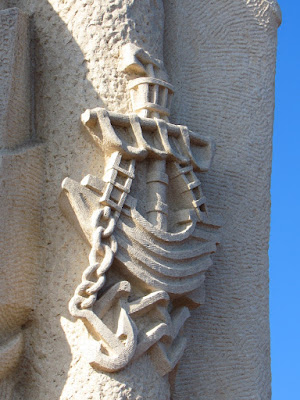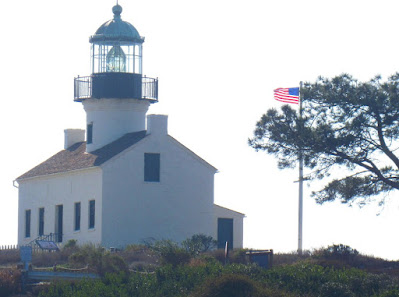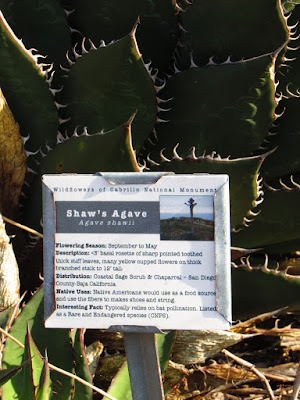Cabrillo National Monument: San Diego
Cabrillo National Monument, established in 1913, commemorates Juan Rodriguez Cabrillo's voyage of exploration.
In September, 1542, Cabrillo arrived at "a very good enclosed port," which is known today as San Diego Bay.
While Cabrillo's contemporaries considered the expedition a failure, it left behind our first written glimpse of the west coast of North America from a newcomer’s perspective. Future Spanish explorers used Cabrillo’s records to better navigate the Pacific.
This was not Steve's first visit to this spectacular place. This photo was taken in 1966. Little Stevie is the 4 year old standing on the wall (along with his mom, two brothers and a family friend).
As you can see, not much has changed in the last 54 years, except for Little Stevie.
This was not just a location for a monument. It also had an important navigational purpose. The Point Loma Lighthouse (1855)—acclaimed as the highest in the U.S.—had not been in service long before it was obvious that its elevation would be its undoing; too often its light was obscured by fog and low clouds. A new Point Loma Light Station was established at a lower elevation in March 1891 (below). The old lighthouse was boarded up and abandoned. The outbuildings disappeared, and vandals broke into the lighthouse and took pieces of it away. In 1913, the commanding officer at Fort Rosecrans recommended the lighthouse be torn down. But because of the magnificent view from the tower, the lighthouse was still quite popular with tourists. It is still here and it is one of the original eight lighthouses on the West Coast, restored and furnished to reflect what life was like in the 1800s.
The 'New' Lighthouse (1891) continues to highlight the coast, not with a fancy Fresnel lens as in its beginning, but via an automated beacon secured on the tower's exterior gallery railing. I do love lighthouses.
It's not surprising that this place has a military history, as well. The Point Loma peninsula forms a natural protective barrier at the entrance to San Diego Bay, rising 422 feet to provide strategic views of the harbor and ocean. In 1852, the government of the United States recognized the importance of this sandstone rampart and designated the area as a military reserve.
In 1899, the War Department dedicated Fort Rosecrans and built a series of gun batteries over the years. During World War I and II, military facilities on the Point provided vital coastal and harbor defense systems. Between 1918 and 1943, the Army constructed searchlight bunkers, fire control stations, and gun batteries. The largest guns were at Battery Ashburn (pictured above) where two 16-inch guns could fire 2,300 pound shells nearly 30 miles out to sea.
There is far more than just human interest here. From the ridge of the peninsula down to the San Diego Bay on the east and the Pacific Ocean on the west, one can see the scrubland habitat. The area includes four community scrub types: southern coastal bluff, maritime succulent, Diegan coastal sage, and southern maritime chaparral. These communities are home to a variety of plant species such as snake cholla, prickly pear cactus, Mojave yucca, Shaw’s agave, California coast poppy, Indian paintbrush, California buckwheat, California sagebrush, and lemonade berry. These plant communities make up the coastal Mediterranean ecosystem and why we need to return in the Spring!
While although only a remnant of the biologically diverse ecosystem Cabrillo saw when he landed here 479 years ago still remains, it is well worth visiting and protecting.
Point Loma and Cabrillo National Monument are well-known in the birding community as some of the premiere bird watching spots in San Diego. The bird checklist for both the monument and the peninsula lists 346 species, with over 270 spotted at Cabrillo National Monument alone.
A stop on the Pacific Flyway, migrant species use the peninsula as a resting place or when lost or disoriented. Raptors use Point Loma as a landmark during the peak of their migrations, and some, like the Red-tailed Hawk, make their home here year-round. The rocky shoreline on Point Loma’s western side is the only place in San Diego where Black Oystercatchers are regulars, and Brandt’s Cormorants roost in large numbers on its cliffs.
And while all the interior exhibits were closed, there was plenty to do, see, and learn. In addition, there are incredible trails yet to be hiked. Oh yes, we will be back.



















1 comments:
Nice flashback photo of Steve!
Looks like there were just as many people there today as there were when Steve visited at four!
Post a Comment